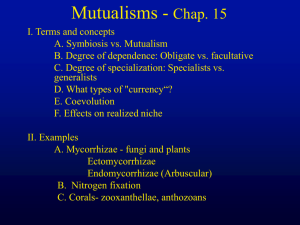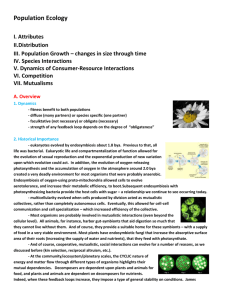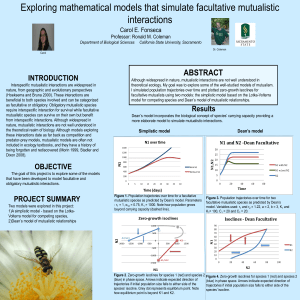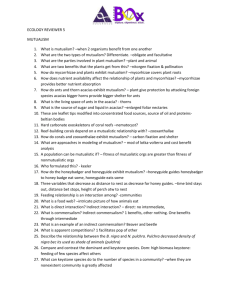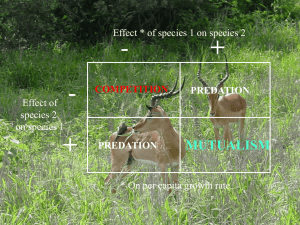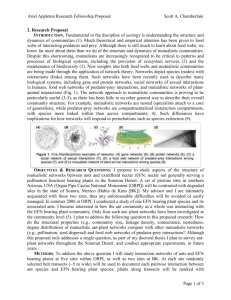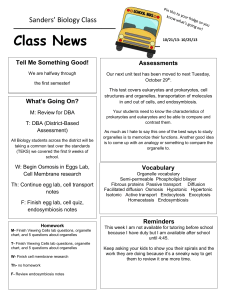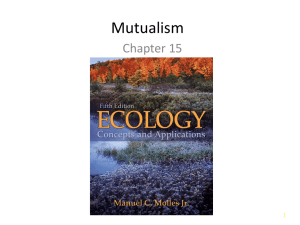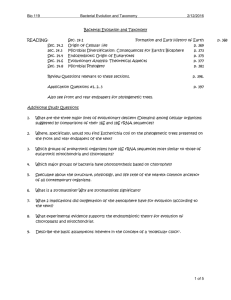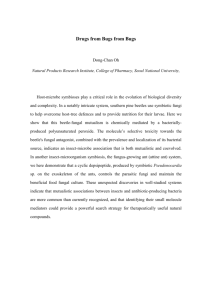Mutualisms I
advertisement
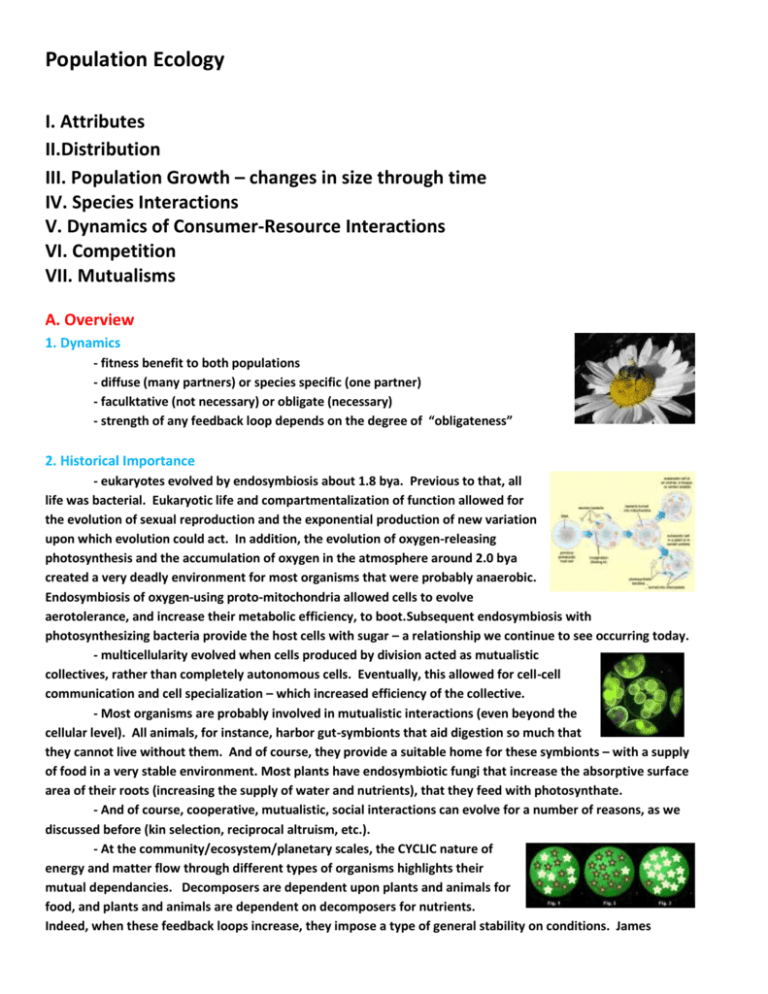
Population Ecology I. Attributes II.Distribution III. Population Growth – changes in size through time IV. Species Interactions V. Dynamics of Consumer-Resource Interactions VI. Competition VII. Mutualisms A. Overview 1. Dynamics - fitness benefit to both populations - diffuse (many partners) or species specific (one partner) - faculktative (not necessary) or obligate (necessary) - strength of any feedback loop depends on the degree of “obligateness” 2. Historical Importance - eukaryotes evolved by endosymbiosis about 1.8 bya. Previous to that, all life was bacterial. Eukaryotic life and compartmentalization of function allowed for the evolution of sexual reproduction and the exponential production of new variation upon which evolution could act. In addition, the evolution of oxygen-releasing photosynthesis and the accumulation of oxygen in the atmosphere around 2.0 bya created a very deadly environment for most organisms that were probably anaerobic. Endosymbiosis of oxygen-using proto-mitochondria allowed cells to evolve aerotolerance, and increase their metabolic efficiency, to boot.Subsequent endosymbiosis with photosynthesizing bacteria provide the host cells with sugar – a relationship we continue to see occurring today. - multicellularity evolved when cells produced by division acted as mutualistic collectives, rather than completely autonomous cells. Eventually, this allowed for cell-cell communication and cell specialization – which increased efficiency of the collective. - Most organisms are probably involved in mutualistic interactions (even beyond the cellular level). All animals, for instance, harbor gut-symbionts that aid digestion so much that they cannot live without them. And of course, they provide a suitable home for these symbionts – with a supply of food in a very stable environment. Most plants have endosymbiotic fungi that increase the absorptive surface area of their roots (increasing the supply of water and nutrients), that they feed with photosynthate. - And of course, cooperative, mutualistic, social interactions can evolve for a number of reasons, as we discussed before (kin selection, reciprocal altruism, etc.). - At the community/ecosystem/planetary scales, the CYCLIC nature of energy and matter flow through different types of organisms highlights their mutual dependancies. Decomposers are dependent upon plants and animals for food, and plants and animals are dependent on decomposers for nutrients. Indeed, when these feedback loops increase, they impose a type of general stability on conditions. James Lovelock created the “Gaia Hypothesis” around this idea, suggesting that life has constructed an environment that is suitable for life – through feedbacks in the hydro- litho- and atmospheres. “Daisyworld” idea with white and black flowers equilibrating the temperature of the world, even as temperature heats up abiotically. 3. Cultural Resistance - Curiously, the importance of mutualistic relationships to biological systems at all levels has been deemphasized, ignored, or ridiculed. Lynn Margulis, the primary proponent of endosymbiosis in the 1960’s, was harshly rebuked and her scientific reputation was attacked. Same with Lovelock, although his ideas were more radical in nature. There is an interesting historical concordance between the industrial revolution, the rise of capitalism, “American individualism” and the “competitive spirit”, and the importance of competition in Darwinian evolution with the de-emphasizing and denigrating of cooperative, mutualistic relationships. This provides yet another interesting example of how science is very much embedded within our culture, and culture influences what questions we think are interesting, and what factors are likely responsible for a pattern. So, an interesting (I hope!) aside. B. Modeling Mutualism 1. L-V models dN1/dt = rN1 ((K1-N1 + aN2)/K1) dN2/dt = rN2 ((K2-N2 + bN1)/K2) 2. Dynamics - the models suggests that each species can live without the other, but does BETTER (“K” increases) when the partner is present. - Curiously, the model predicts two outcomes – one in which there is a positive feedback loop and both species increase forever… (hmmm…), and the other describing a situation in which a stable equilibrium is possible. - We can change it so they are obligate (set K’s less than zero when alone), but this only creates an unstable equilibrium. However, there seem to be some fairly stable obligate relationships. Study Questions: 1) Distinguish between a diffuse and an obligate mutualism, giving an example of each. 2) How were mutualisms involved in the major evolutionary steps of the evolution of eukaryotes and the evolution of multicellularity? 3) What cultural factors may have resisted the acceptance of mutualisms as a major evolutionary force? 4) Write the L-V equations for two non-obligate (facultative) mutualists. What unrealtistic outcome is possible? What realistic outcome is possible? How were these changed to represent obligate relationships, and what type of equilibrial outcome is possible?

